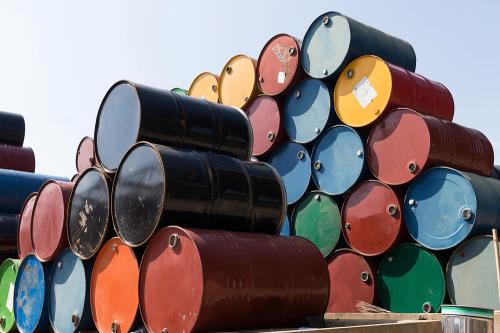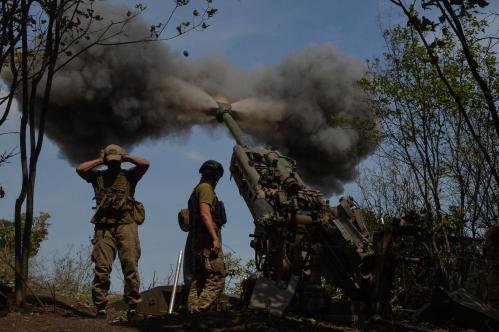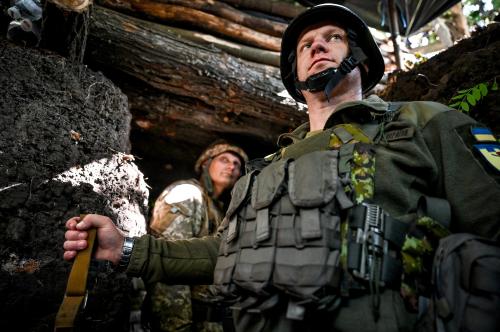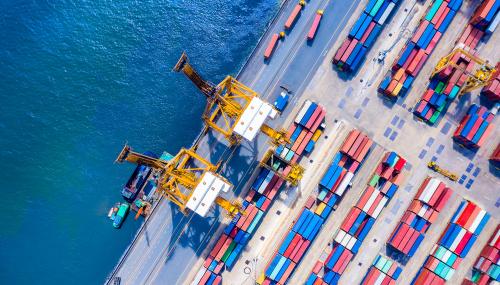Russia’s most recent invasion of Ukraine on February 24 triggered the largest conflict in Europe since World War II with devastating and enduring humanitarian and economic consequences. According to the United Nations, it has forced nearly one-third of Ukrainians from their homes (dispersing 7.8 million refugees throughout Europe and displacing 6.2 million internally) and killed or injured more than 16,000 civilians. (The UN notes actual casualty numbers likely are considerably higher.) The war has destroyed at least $127 billion of the nation’s buildings and other infrastructure, according to the Kyiv School of Economics. The International Monetary Fund (IMF) projects that Ukraine’s GDP will decline 35% this year. Inflation is running at more than 20%, in large part because the government is relying on the central bank to finance its budget deficit.
Ukraine’s allies—including members of the European Union (EU) and the United States—have provided billions of dollars’ worth of military assistance and humanitarian relief. In May, President Biden signed a $40 billion package of assistance into law, and he signed an additional $12.3 billion package of assistance into law in September. The administration was aiming to disburse $13 billion of economic assistance in 2022.
Even as Ukraine continues its efforts to reclaim territory occupied by Russia, the Ukrainian government and those of its allies, as well as international financial institutions and think tanks around the world, are planning the governance and financing of its recovery in the months immediately after the war and its longer-term reconstruction and modernization. Though the duration of the war remains uncertain, all parties believe now is the time to begin planning for Ukraine’s future.
This background paper summarizes various proposals for organizing the post-war reconstruction of Ukraine. The governments of Ukraine and donor countries are currently discussing a “coordination platform” for aid.
Reconstruction Planning
Soon after the invasion, the governments of Ukraine and its allies, international financial institutions, and non-governmental policy and research organizations began developing economic reconstruction plans of varying degrees of detail and with widely varying estimates of the funding needs:
- The World Bank published a paper in April on Ukraine’s short-term relief and longer-term reconstruction needs (subsequently estimated at $349 billion and rising as of June 1).
- The London-based Centre for Economic Policy Research (CEPR) offered A Blueprint for the Reconstruction of Ukraine, also in April, with an estimated cost of €200 billion to €500 billion, increasing as the war continues. In August, CEPR issued Macroeconomic Policies for Wartime Ukraine, which outlined policies to put the Ukrainian economy on a sustainable trajectory for the duration of the war.
- The European Commission in May issued its RebuildUkraine Jointly with the World Bank, it later estimated costs of reconstruction, as of June 1, at $349 billion and rising.
- The Ukrainian government presented a 10-year, $750 billion plan in July at the Ukraine Recovery Conference in Lugano, Switzerland.
- The German Marshall Fund of the United States (GMF), headquartered in Washington, D.C., published Designing Ukraine’s Recovery in the Spirit of the Marshall Plan in September.
Other institutions have provided emergency assistance and suggested they would contribute to post-war reconstruction. The IMF has disbursed $2.7 billion in emergency support so far and set up an account for donor countries to channel aid to Ukraine. The European Investment Bank (EIB) has approved two support packages totaling nearly €2.3 billion and the European Bank for Reconstruction and Development (EBRD) has provided €2 billion of immediate relief.
In July, the Washington-based Center for Strategic and International Studies (CSIS) launched a Ukraine Economic Reconstruction Commission to create a framework for the reforms necessary for Ukraine to attract private investment. And organizations ranging from GLOBSEC, a think tank based in Bratislava, Slovakia, to the international management consulting firm Deloitte have weighed in.
A conference of donors was held in Lugano, Switzerland, in July. Another is scheduled for 2023 in the United Kingdom. In October, the European Commission and Germany, as president of the Group of Seven, hosted an “international expert conference” on reconstruction in Berlin.
Reconstruction Principles
Plans published so far have much in common. They largely agree that:
- The overarching goal of reconstruction should be to transform Ukraine’s economy and society by modernizing—not only its infrastructure, but also its economic, political, and social institutions, thus providing a decisive break from Ukraine’s Soviet past and paving the way for it to join the EU. Several plans use the phrase “build back better.”
- Ukrainians should take the lead in setting priorities for reconstruction and implementing it. Ukrainian representation should be diverse, including both national and local government officials, as well as leaders from civil society and the private sector.
- Donor countries and institutions should rigorously and cooperatively oversee their reconstruction assistance to ensure the program’s goals are achieved and Ukraine’s endemic corruption thwarted. Essential elements of effective oversight include transparent procurement and financial management processes, clear achievement mileposts, and independent oversight and auditing mechanisms.
- Reconstruction will take time—several plans mention 10 years—but continuing assistance indefinitely would undermine Ukraine’s ability to achieve self-sufficiency. Assistance, at least in the early stages of reconstruction, should be primarily in the form of grants to avoid saddling Ukraine with unmanageable debt.
Reconstruction Coordination
The plans also agree that, to avoid working at cross purposes and to ensure effective oversight, donors must coordinate the administration of their reconstruction assistance. But the plans differ significantly on how that coordination should be structured and who should lead it.
The Marshall Plan—the U.S. program from 1947 to 1951 to rebuild Europe after the devastation of World War II—is often cited as an inspiration for the reconstruction of Ukraine, but administratively it was the opposite of the current situation. One nation—the United States—was the donor, and 16 European countries were the recipients. With Ukraine, one nation will be the recipient, and many nations and international institutions will be the donors—posing a coordination challenge.
Views on administering assistance and coordinating among donors vary. The World Bank established a multi-donor trust fund. The IMF is developing a new monitoring instrument (called Program Monitoring with Board Involvement).
The European Commission calls for an “international coordination platform,” co-led by the Commission and the Ukrainian government. The details for such a platform are the subject of ongoing negotiations between the Commission, the Ukrainian government, and members of the G7. (The members are the United States, Great Britain, Canada, Germany, France, Italy, and Japan, plus the EU.)
CEPR proposes to manage assistance through a new stand-alone agency created or authorized by the EU. The IMF and World Bank could provide technical assistance but—because some of their member nations may not be interested in seeing Ukraine succeed economically—should not administer the aid, according to the CEPR.
The German Marshall Fund of the United States suggests that the G7 should take the lead in partnership with the Ukrainian government, while allowing opportunities for the participation of non-G7 countries such as Australia. According to GMF, the coordination effort should be headed initially by “an American with a global stature.”
The Plans, So Far
Ukraine’s National Recovery Plan
Ukrainian Prime Minister Denys Shmyhal presented the plan at the Lugano conference, July 4-5.
Funding and Timeline: The 10-year plan is divided into two phases, 2023-2025 and 2026-2032, and encompasses 850 wide-ranging projects requiring funding totaling an estimated $750 billion.
Priorities: The two biggest components of the plan are the reconstruction and modernization of housing and infrastructure ($150 billion to $250 billion; 103 projects and activities) and expanding logistical and transportation facilities (airports, railroads, roads, ports) and integrating them with the EU ($120 billion to $160 billion; 145 projects and activities). Other big-ticket items include achieving energy independence and developing green energy ($130 billion; 21 projects and activities), ensuring access to funding through insurance, loan guarantees, and other programs ($75 billion; 21 projects and activities), and supporting high-tech and other potentially fast-growing economic sectors ($50 billion; 34 projects and activities).
Donor Coordination: The plan does not include a specific donor coordination structure, but Ukraine subsequently circulated a proposal to create a recovery fund with a supervisory board on which three-quarters of the seats would be held by representatives of donors.
Oversight: The plan asserts that strengthening Ukrainian institutions and “de-oligarchization” are its “fundamental prerequisites”—including public data transparency, relaunching anti-corruption offices, reforming law enforcement agencies, implementing corporate governance legislation, and synchronizing anti-trust practices with the EU.
The European Commission: RebuildUkraine Plan
The overarching goal of the European Commission’s RebuildUkraine plan, published May 18, is the creation of “a free and prosperous country, anchored in European values, well integrated into the European and global economy.”
Funding and Timeline: When the Commission issued its plan, it said the overall funding needed was not yet known, but that it would be “substantial,” and that reconstruction would “potentially span more than a decade.” In September, jointly with the World Bank and the government of Ukraine, it estimated the cost of recovery and reconstruction as of June 1 at $349 billion and said it was expected to grow.
Priorities: The plan outlines four pillars: 1) rebuilding “infrastructure, health services, housing, and schools, as well as digital and energy resilience in line with the most recent European policies and standards”; 2) providing administrative and technical support so that Ukraine can continue modernizing its institutions “to ensure good governance and respect for the rule of law”; 3) a structural and regulatory agenda in Ukraine that would deepen “the economic and societal integration of Ukraine and its people with the EU”; and 4) promoting Ukraine’s “green and digital transition” through sustainable economic competitiveness, trade, and private-sector development.
Donor Coordination: The Commission envisions an international coordination platform co-led by it and the Ukrainian government. It would serve as “an overarching and single-entry point for all actions on the reconstruction of Ukraine” and would work with EU member states, other countries, and international financial institutions. The platform would determine priorities for financing and specific projects for implementing priorities. It would coordinate financing sources and monitor progress. The plan calls for the creation of a RebuildUkraine Facility, embedded in the EU budget, to serve as the legal instrument for providing EU grants and loans.
Oversight: European Commission President Ursula von der Leyen said investments in Ukraine will “go hand in hand with reforms that will support Ukraine in pursuing its European path.” The plan did not detail specific oversight mechanisms but said the RebuildUkraine Facility “would put significant emphasis on good governance, the rule of law, sound financial management as well as anti-corruption and anti-fraud proofing.”
The World Bank: Relief, Recovery and Resilient Reconstruction
The World Bank staff, in a paper published April 21, wrote that during reconstruction “Ukraine will have the opportunity to finally shake off some of the legacies of the past and leapfrog to a more productive, sustainable and inclusive society.” This requires not just rebuilding housing and infrastructure, they wrote, but also “institutions that enable building a dynamic economy … anchored in Ukraine’s strong commitment to become a member of the European Union.”
Funding and Timeline: The paper divided economic assistance into three phases: relief during the war, recovery during the first six-to-eight months after the war, and “resilient reconstruction” in “the medium term.” Jointly with the European Commission and the government of Ukraine, the World Bank in September estimated recovery and reconstruction needs at $349 billion and growing as of June 1. The paper identified “three critical pathways” for transfer of resources from abroad: grants through the World Bank and IMF; loans at below-market rates and for extended terms; and donor-country guarantees of loans from international financial institutions.
Priorities: The plan enumerated “four critical directions” for reconstruction: 1) fundamentally reforming Ukraine’s public finances and financial sector, including through a lower and more fairly applied tax rate and less dependence on domestic banks; 2) stimulating entry and growth of new technologically advanced businesses to take advantage of trading opportunities with the EU; 3) rebuilding public social services, especially a high-quality education system and a network of health facilities; and 4) building sustainable energy, transportation and other infrastructure that aligns with the EU’s “green deal.”
Donor Coordination: The paper notes the World Bank’s multi-donor trust fund and an IMF-administered account as vehicles for assistance and mentions that “a critical need for Ukraine’s external partners is to closely coordinate all their resources.”
Oversight: The report does not describe specific oversight mechanisms but calls for technical support to strengthen Ukraine’s anti-corruption agencies and reviving efforts to ensure Ukraine’s judiciary is professional, non-corruptible, and fair.
The Centre for Economic Policy Research: A Blueprint for the Reconstruction of Ukraine[1]
CEPR, a network of research economists, many at European universities, published its plan early in the war, on April 8, with the hope that it would lead to a broader project with a deeper analysis of how best to reconstruct Ukraine. It said international assistance should put Ukraine on the path to joining the EU, should be rapid but conditioned on accountability and milestones, and should focus on grants rather than loans because a country destroyed by war cannot be expected to repay additional debts. It said donors should closely coordinate assistance with each other and with Ukraine to minimize waste and delay and that Ukrainians (including at the local level) should “own” reconstruction by matching a fraction of the aid and be able to continue projects after international assistance ends.
Funding and Timeline: Like other plans, it divides reconstruction into three post-war phases: the emergency response (the first 6 months, akin to the response to a natural disaster), restoration of critical infrastructure and services (3 to 24 months); and laying the foundation for future growth and modernization (medium- to longer-term). It estimates reconstruction costs at €200 billion to €500 billion but warned that costs were increasing as the war continued and could cumulate as high as $1 trillion. It identified several potential sources of financing, including grants, loans, and loan-guarantees from allied governments; multilateral institutions such as the World Bank, EBRD, and European Investment Bank; private foundations and individuals; and seized Russian assets.
Priorities: Reconstruction, according to the CEPR paper, offers “a unique opportunity to radically upgrade Ukraine’s productive capacity to bring it close to the technological frontier, [and] lay foundations for long-term growth.” The success of aid will depend on Ukraine’s ability to export to the EU, it said, so should come with incentives for Ukraine to align its regulatory and legal environment with the EU’s. And it should encourage and facilitate inflows of foreign capital and technology transfers by subsidizing and insuring investments and by privatizing Ukraine’s two large state-owned banks. A key to modernization, the authors write, will be replacing the remnants of Ukraine’s Soviet past with a “liberal economic framework” that includes reforming its tax code and labor laws, giving more political and economic authority to local governments, and removing remaining restrictions on land ownership. Infrastructure improvements should include robust transportation connections (railroads, highways, pipelines, and bridges) and rebuilt housing, hospitals, and schools to attract displaced Ukrainians back to their pre-war residences. Energy investments should focus on integrating Ukraine into the European energy network and reducing its dependence on fossil fuels.
Donor Coordination: The paper notes that a self-standing U.S. agency successfully administered the Marshall Plan after World War II and recommends establishing an independent EU-affiliated agency. It would coordinate Ukraine assistance across diverse aid sources and function as a “single interlocuter” with Ukrainian authorities. An independent agency would minimize the political influence of Russia, which is a shareholder in the IMF, World Bank, and EBRD, the authors write. The governance structure of the agency should be “technocratic in nature” and include Ukraine. To avoid creating an entrenched bureaucracy, the agency should be authorized with sunset provisions linked to Ukraine becoming a member of the EU.
Oversight: The independent agency should set project timelines and goals and monitor results in collaboration with Ukrainian authorities and should be able to withhold or delay funding. It should implement strong anti-corruption protocols, relying upon site visits, third-party verification, protections and financial incentives for whistleblowers, and a partnership with the European Public Prosecutor’s Office.
The German Marshall Fund of the United States: Designing Ukraine’s Recovery in the Spirit of the Marshall Plan[2]
The German Marshall Fund of the United States, a U.S.-based think tank founded through a gift from the German government to commemorate the 25th anniversary of the Marshall Plan, looks to history for inspiration for Ukraine’s reconstruction in the plan published September 7. It draws six lessons: 1) to deliver hope to Ukrainians during the war, planning should begin now for a prosperous, secure future; 2) U.S. officials must work hard to win both broad public support and strong bipartisan congressional backing for assistance to Ukraine; 3) Ukraine should lead its own reconstruction, but donors must approve the plans and monitor implementation; 4) assistance should be delivered in an accountable and transparent framework and progress from humanitarian relief to economic recovery and modernization; 5) the underlying goal must be economic integration with Europe; and 6) assistance should be time-limited and carefully coordinated among donors. GMF draws a seventh lesson from Ukraine’s recent past: Donors should closely involve Ukraine’s non-governmental organizations, which have emerged as trusted watchdogs, to ensure the integrity of the government’s anti-corruption agencies are maintained.
Funding and Timeline: A paper published by the GMF in September cites the Ukrainian government’s $750 billion reconstruction cost estimate and 10-year timeline but does not offer its own, because “the fog of war lies thick over Ukraine, and the total costs of the conflict are hidden in the mist.” Recovery should consist of four stages: relief, reconstruction, modernization, and accession to the EU. It said donors should weight their contributions toward grants rather than loans because Ukraine will not be “investable” soon. Sovereign guarantees for private investments should be introduced and, in time, using seized Russian assets should be considered, it said.
Priorities: The paper does not recommend specific priorities for investments and instead focuses on a structure (a task force with sectoral working groups) for Ukraine and its international partners to determine funding needs and set priorities.
Donor Coordination: The GMF paper asserts that the European Commission has “neither the necessary political nor the financial heft” to lead reconstruction. And it advises against creating a new agency or centralized trust fund. Instead, it suggests that the G7 and Ukraine together appoint “an American of global stature” as recovery coordinator “because only the United States will be able to bring together the needed global coalition and forge consensus among Ukraine’s partners.” The coordinator, in turn, would build a Ukraine Reconstruction and Recovery Task Force. Each G7 country would appoint a senior representative to the task force. The EU, as a G7 member, would serve as the secretariat and convenor of the task force, which would rely on European Commission staff. The task force would form sectoral working groups (such as agriculture, infrastructure, housing, energy, water, sanitation, and industrial capacity) co-led by G7 and Ukrainian officials. International financial and multilateral institutions, philanthropic organizations, and large private-sector leaders could apply to be members of, or observers to, the task force.
Oversight: According to the paper, “aid to Ukraine needs to come with strings attached,” given the country’s history of corruption. The first tranche of reconstruction funds should be contingent on Ukraine implementing rule-of-law and judicial reforms. The EU should invite Ukraine to join the European Public Prosecutor’s Office. An independent inspector general should be appointed to investigate misconduct and ensure efficient use of funds. And the task force should create a digital platform to promptly publish as many reconstruction-related documents as possible.
Other Participants and Views
International Monetary Fund: The IMF has disbursed two rounds of emergency financial support to Ukraine—$1.4 billion in March and $1.3 billion in October. In April, the IMF set up an “administered account” for donor countries to channel aid to Ukraine. As of mid-September, Canada and Germany had provided $2.2 billion through it, and Belgium and the Netherlands planned to use it. The IMF has also begun developing a new instrument—“Program Monitoring with Board Involvement”—to validate the Ukrainian government’s projections and to administer “a full-fledged IMF program once conditions allow,” according to IMF Managing Director Kristalina Georgieva. Its goal is to work with Ukrainian authorities on “a comprehensive macroeconomic framework, with policy undertakings and quantitative targets, that will clarify external financing needs and provide a guide for both domestic policymaking and international support,” she said.
European Investment Bank: The EIB, the EU’s lending arm, approved two lending packages for Ukraine—€668 million in March and €1.59 billion in July—to meet urgent needs, including the repair of the most essential damaged infrastructure. (The loans were guaranteed by the EU.) EIB President Werner Hoyer promised in October that the bank would continue to support Ukraine “for the reconstruction of a free, prosperous country.”
European Bank for Reconstruction and Development: The EBRD—owned by 72 countries, the EU, and the EIB—was founded in 1991 to create a post-Cold War era in central and eastern Europe. Since the invasion began, the EBRD has committed more than €1 billion in loans and aims to triple that by the end of 2023, primarily to maintain energy and food security, restore rail infrastructure, and support the pharmaceutical industry.
The Center for Strategic and International Studies: CSIS, a non-profit policy research organization based in Washington, D.C. and focused on national security issues, in July launched a bipartisan and international Ukraine Reconstruction Commission. It is led by three co-chairs: Paula J. Dobriansky, former under secretary of state in the George W. Bush administration; Greg Page, former chief executive officer and chair of Cargill, a global food corporation; and Michael Polsky, founder and chief executive officer of Invenergy, a multinational power generation company. The commission aims to “produce a framework for the crucial reforms needed to attract private-sector investment to support Ukraine’s economic reconstruction.” It will seek to align its work with Ukraine’s National Recovery Plan and aims to produce a series of policy papers on specific topics, such as agriculture, energy, transportation and logistics, and corruption.
GLOBSEC: GLOBSEC, a nonpartisan think tank based in Bratislava, Slovakia, established a Ukraine Support Council in September, chaired by Jan Krzysztof Bielecki, former prime minister of Poland. And in October, GLOBSEC opened an office in Kyiv. The Council will focus on Ukraine’s accession to the European Union and the reconstruction of Ukraine, as well as its integration into Central Europe. It will provide “tailor-made advice in the form of sets of studies and pilot projects.” Council members will include Ukrainians, other Europeans, and Americans.
Deloitte:[3] The international management consulting firm Deloitte published The reconstruction of Ukraine: Historical lessons for postwar reconstruction of Ukraine in October. It said reconstruction “is more than just rebuilding roads and factories” but should help Ukraine “reemerge a stronger country that is part of a stronger Europe.” It identified five areas as starting points for reconstruction: physical infrastructure, education and workforce, the financial sector, government services and revenue, and agriculture. It did not recommend a specific structure for overseeing and coordinating international assistance but said it should be done by “a single central institution.” That institution could be “a single nation, a multilateral organization, or any number of other organizational structures,” it said, adding, “involvement and leadership from the United States and the EU are key.”
[1] The authors are Stephen Lewarne, Nell Todd, Joe Mariani, Joniel Sung-Jin Cha, and Stuart Williamson.
[2] The authors are Ronja Ganster, Jacob Kirkegaard, Thomas Kleine-Brockhoff, and Bruce Stokes.
[3] The authors are Torbjörn Becker, Stockholm School of Economics; Barry Eichengreen and Yuriy Gorodnichenko, University of California-Berkeley; Sergei Guriev, Sciences Po; Simon Johnson, Massachusetts Institute of Technology; Tymofiy Mylovanov, Kyiv School of Economics; Kenneth Rogoff, Harvard University; and Beatrice Weder di Mauro, Graduate Institute Geneva.
The Brookings Institution is financed through the support of a diverse array of foundations, corporations, governments, individuals, as well as an endowment. A list of donors can be found in our annual reports published online here. The findings, interpretations, and conclusions in this report are solely those of its author(s) and are not influenced by any donation.
The Brookings Institution is committed to quality, independence, and impact.
We are supported by a diverse array of funders. In line with our values and policies, each Brookings publication represents the sole views of its author(s).









Commentary
Financing and governing the recovery, reconstruction, and modernization of Ukraine
November 3, 2022